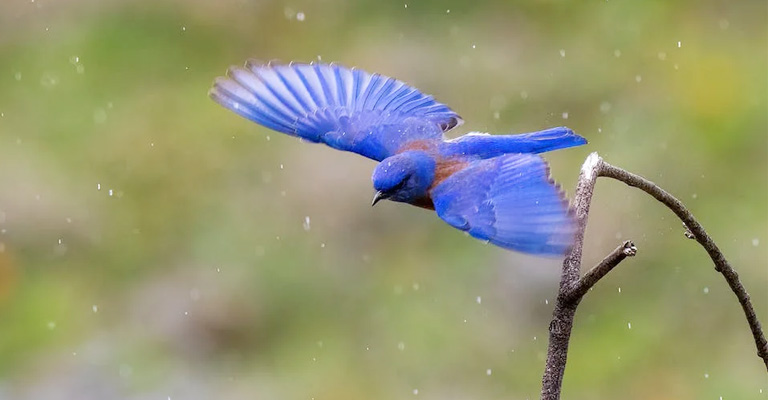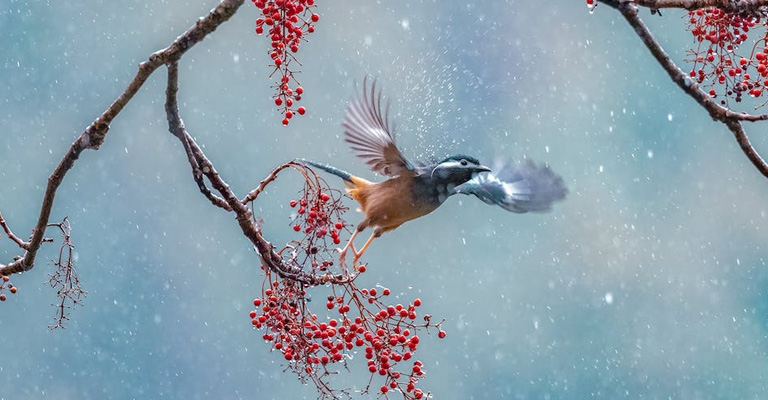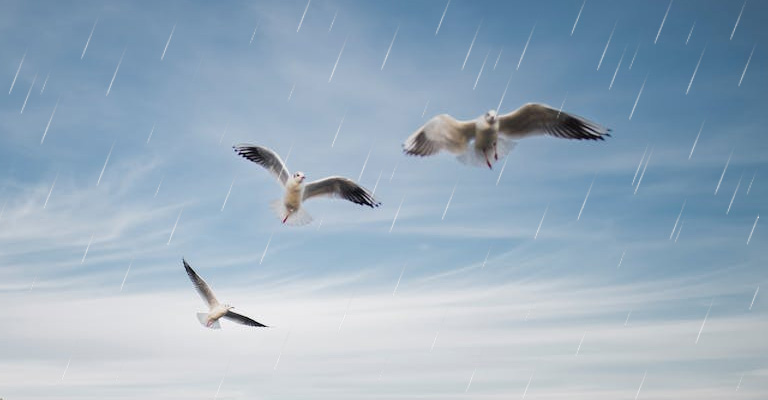The skies offer an ethereal expanse for birds to traverse, but when raindrops begin to fall, their airborne journey takes an intricate turn. Have you ever wondered how do birds see where they are going when flying in the rain?
The avian ability to seamlessly maneuver through wet weather reveals a fascinating blend of biology and adaptation. Raindrops create dynamic challenges for birds in flight, from altering visibility to affecting aerodynamics.
Despite these obstacles, birds have evolved remarkable strategies that allow them to continue their flights with surprising precision.
In this exploration, we delve into the captivating world of avian vision and the mechanisms that enable birds to see where they’re going amidst the downpour.
Join us as we unravel the mysteries of avian flight in rainy conditions and gain insights into the astonishing capabilities of our feathered companions.

How Do Birds See Where They Are Going While Flying in the Rain?
Birds possess remarkable adaptations that help them navigate and see where they’re going even in challenging weather conditions like rain. Here are the details:
Enhanced Vision
Birds have evolved a set of visual adaptations that aid them in flying through the rain without losing their way.
Many birds have excellent vision, with a higher density of photoreceptors in their retinas. This allows them to gather more light and perceive finer details, even in low-light conditions like rain.
Color Vision
Most birds can see a broader spectrum of colors than humans, including ultraviolet light. This might help them distinguish between objects and navigate more effectively, even in rainy conditions.
Fast Visual Processing
Birds’ brains process visual information much faster than human brains. This rapid processing enables them to react quickly to changes in their surroundings, such as raindrops.
Lower Flight Altitude
Birds also employ certain behavioral strategies to ensure they can see where they’re going while flying in the rain.
When flying in rainy conditions, birds often lower their flight altitude. By flying closer to the ground or trees, they reduce the distance that raindrops have to fall before they hit the bird, minimizing the impact on their vision.
Alternate Flight Patterns
Some birds may alter their flight patterns to minimize the impact of raindrops. They might fly in zigzag patterns or make sudden turns, which can help avoid direct collisions with raindrops.
Utilizing Cover
Birds may take advantage of natural cover, such as flying near the shelter of trees or cliffs, to shield themselves from heavy rain and maintain clearer visibility.
Preen Oil
Finally, birds’ feathers have certain water-resistant properties that can help them maintain visibility during rainy flights.
Many birds produce preen oil from a gland near their tails. They use this oil to groom their feathers, which helps make their plumage more water-resistant.
Water-resistant feathers allow raindrops to roll off the surface rather than soak in, reducing interference with their vision.
Feather Structure
The structure of bird feathers plays a role in shedding water. The arrangement of interlocking barbs and barbules prevents rain from penetrating deep into the feathers, preserving visibility.
Where Do Birds Go in the Rain?

During rain, birds have several strategies for finding shelter and protecting themselves from the elements:
Trees and Shrubs
Many birds seek refuge in trees and shrubs. The dense foliage provides cover from raindrops, and the branches offer a perch to rest on. Some birds might even huddle close to the trunks to minimize exposure to rain.
Nests
Birds’ nests, if well-constructed, can provide a relatively dry and sheltered space. Birds often retreat to their nests during rain to wait out the bad weather. However, not all birds’ nests are completely waterproof, so heavy rain could still pose a challenge.
Under Eaves and Roofs
Urban birds sometimes take advantage of man-made structures like buildings. They might seek shelter under eaves, on ledges, or even in nooks and crannies of buildings to stay dry.
Caves and Rock Overhangs
In more natural environments, birds might find shelter in caves, rock crevices, or under rocky overhangs. These formations offer protection from rain and wind.
Tall Grass or Vegetation
Some ground-dwelling birds might take cover in tall grass or dense vegetation. These areas provide some protection from rain and offer camouflage.
Waterproof Feathers and Preening
As mentioned earlier, birds have water-resistant feathers. They can use their beaks to spread preen oil across their feathers, helping to maintain their waterproofing and minimize the impact of rain.
Migration
In some cases, if the rain is part of a larger weather system, birds might adjust their migration patterns. They could delay their departure or find suitable resting spots along their migration route until the rain passes.
Behavioral Adaptations
Some birds might alter their behavior during rain. They may reduce their activity level, stay quiet, and conserve energy until the weather improves.
It’s important to note that not all birds have the same strategies, and their response to rain can vary based on factors like species, habitat, and the intensity of the rain.
Additionally, while some birds seek shelter, others might continue foraging in the rain if the rain isn’t too heavy or prolonged.
Are Birds Waterproof?

Birds are not completely waterproof, but they do possess adaptations that make their feathers highly water-resistant.
These adaptations help birds stay relatively dry and maintain their ability to fly and regulate body temperature even in wet conditions. Here’s how birds achieve this water-resistant quality:
Preening
Birds have a special gland near the base of their tail called the uropygial gland or preen gland. This gland produces a waxy substance known as preen oil. Birds spread this oil over their feathers using their beaks during grooming.
Preen oil serves to coat the feathers, making them water-resistant and preventing water from soaking in.
Feather Structure
Bird feathers have a unique structure that aids in shedding water. The feathers are made up of a central shaft (rachis) with interlocking barbs and barbules.
The barbules have tiny hook-like structures that zip the feathers together, creating a continuous surface. This structure prevents water from penetrating deep into the feathers. Instead, water droplets tend to roll off the surface.
Feather Overlap
Birds have overlapping feather layers, with the outer feathers covering the inner ones. This arrangement acts as an additional barrier against water infiltration, keeping the underlying layers of feathers relatively dry.
Posture and Behavior
During rain, birds often adjust their posture to minimize water exposure. They might tuck their heads under their wings, hunch their bodies, or fluff up their feathers to create an insulating layer of air.
While these adaptations make birds highly water-resistant, they are not completely impervious to water. Heavy or prolonged rain can still wet a bird’s feathers and impact its ability to fly effectively.
How Do Birds Fly in the Rain?

Birds are adapted to fly in various weather conditions, including rain. While flying in the rain presents some challenges, birds have evolved a combination of physical adaptations and behavioral strategies that allow them to navigate the skies even when it’s wet:
Aerodynamic Design
Birds have evolved streamlined and aerodynamic body shapes that reduce air resistance. This design helps them maintain stable flight in windy and rainy conditions by minimizing the impact of air currents.
Strong Muscles
Birds possess powerful flight muscles, particularly the pectoral muscles responsible for flapping their wings. These muscles enable birds to generate sufficient lift and thrust, allowing them to overcome the added resistance from raindrops.
Wing Flexibility
Birds can adjust the angle and shape of their wings during flight. This flexibility allows them to adapt to changing weather conditions, including rain and wind, and maintain stable flight trajectories.
Rapid Reflexes
Birds have fast reflexes and quick reaction times. This helps them respond swiftly to changes in wind patterns, rain intensity, and other factors that could affect their flight.
Feather Adjustments
Birds can adjust their feather positioning during flight. In rainy conditions, they might flatten their feathers against their bodies to reduce air resistance and minimize the impact of raindrops.
Balancing Techniques
Birds use their tails and body movements to maintain balance during flight. This becomes crucial in rainy weather when raindrops could disrupt their stability. Birds adjust their tail and body positions to counteract the effects of rain.
Wing Flapping Frequency
In light rain, birds might increase their wing flapping frequency to generate more lift and counteract the dampening effect of rain on their feathers. This helps them maintain a steady flight despite the additional resistance.
Flight Altitude
During heavy rain, birds might fly at lower altitudes to minimize the distance that raindrops fall before hitting them. Flying closer to the ground or trees can reduce the impact of rain and improve visibility.
Navigation Skills
Birds often rely on visual cues for navigation, including landmarks and celestial cues. In rainy conditions with reduced visibility, they might adjust their navigation techniques or rely more on other senses like hearing.
Resting and Waiting
In some cases, birds might temporarily pause their flight and perch on a sheltered surface, such as a tree branch or under an overhang, until the rain subsides. This allows them to rest and wait out the unfavorable weather.
FAQs
Birds puff up their feathers in cold or rainy conditions as a way to trap warm air close to their bodies.
This behavior helps them maintain their body temperature and conserve heat. The insulating layer of air between the feathers and the body acts as a natural barrier against cold or damp weather.
Birds’ migration patterns can be influenced by various factors, including weather conditions.
In some cases, birds might delay their migration or seek shelter during rainy weather. They might take advantage of resting spots along their migration route until the rain clears.
Birds have adaptations that allow them to fly in various weather conditions, including light to moderate rain. However, heavy rain can pose challenges due to the increased resistance from raindrops and potential waterlogging of feathers.
Some birds continue foraging in light rain because rain can bring insects and other prey to the surface.
Additionally, the sound of raindrops hitting leaves and the ground can mask the noise of their movements, making it easier for them to approach prey without being detected.
Birds have keen senses that help them locate food even in rainy conditions. Many birds rely on their excellent eyesight to spot moving prey or forage on the ground. Rain can displace insects and other invertebrates, making them more accessible to birds.
Parting Thoughts
As we conclude our journey through the rain-soaked skies with our avian friends, we are left in awe of the extraordinary adaptations that allow them to navigate effortlessly in challenging conditions.
The ability of birds to see where they’re going while flying in the rain is a testament to the intricate interplay between nature’s design and the demands of survival.
From rapid eye movements that aid in tracking their surroundings to specialized visual adaptations that minimize the impact of raindrops on their vision, these airborne marvels have honed their skills over countless generations.
As we look to the skies, let us remember that every flight in the rain is a reminder of the astonishing ways in which life adapts to its environment. So the next time you see a bird soaring through a drizzle, take a moment to marvel at the artistry of nature.